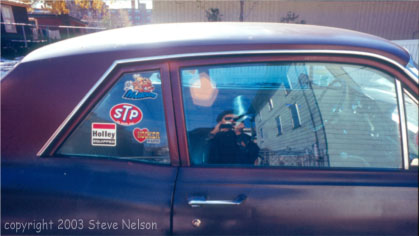 Artist's Statement
Artist's Statement
|
Harvard Square is the commercial district adjacent to Harvard University in Cambridge, Massachusetts. A quiet college town for over 300 years, in the late '60s and early '70s it seethed with political activism and youth pop culture. It was a unique place during that time, and a unique time for that place. The boundaries of the Square were defined not by streets and signs, but by a state of mind. When you were in it, you knew it.
I was part of "the scene" there. I made sandals, wrote for and hawked underground newspapers, produced rock concerts (including a stint as manager of The Boston Tea Party), ran for Cambridge City Council (but lost), and wrote a book of poetry with my girlfriend Jan which we sold on the streets of the Square. I went to my share of antiwar demonstrations, but mostly I just hung out in cafes and cafeterias, walked the streets of Cambridge and the banks of the Charles River with my dog B.B., listened to music, read books, partied, made love, and took pictures.
My first experience with photography was in Peru, where I spent the summer of '61 living in an Indian village in the Andes. I took my father's camera with me to shoot the local people, the spectacular scenery and Inca ruins. Just as I saw Peru with the eye of an anthropologist, so did I see the people, places and artifacts of the Square a few years later. Sometimes I imagined I was an archaeologist from the future collecting images of Square life and culture from that period. But in reality this was my life, my friends, the place where I lived and the people who lived there.
When taking these pictures, I did not think of myself as Making Art, but as using a camera as a way of seeing, as Carlos Castaneda said. I grew up with an appreciation for artists like Van Gogh and Picasso, and photographers like Weston and Cartier-Bresson. In fact, it was my fascination with pre-Columbian art that put me on the path to Peru. I shot color slides there, so naturally I used that medium to shoot in the Square. Real Artists, I thought, photographed in black-and-white, and it would be decades before I even knew who William Eggleston and Gary Winograd were. It was not contemporary photographers who influenced my work so much as '60s filmmakers like Antonioni, Fellini, Bergman and, in so many ways, Andy Warhol.
A few of my images from that period have been exhibited before, notably in Photovision '72, but most have never been shown or published. Computer technology has provided me the tools to unearth these relics of a vanished culture, in an age before PCs, CDs, VCRs and cable TV. What you won't see here are sit-ins in Harvard Yard or marches on Mass. Ave. They've been well documented by many others. These images from the scene in the Square are not about the politics and protests of the Sixties, but about the life we lived from day to day in that time and place.
|
|